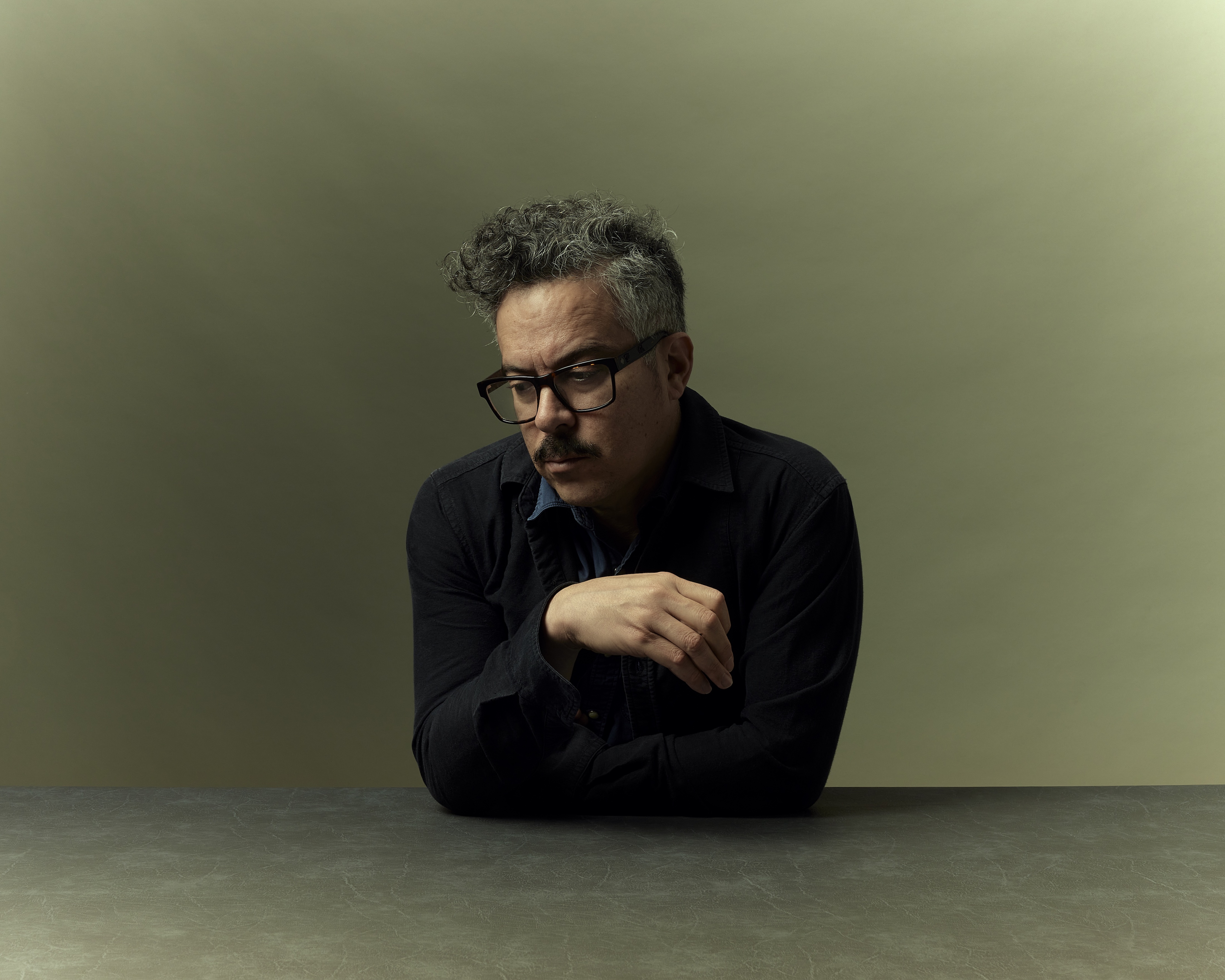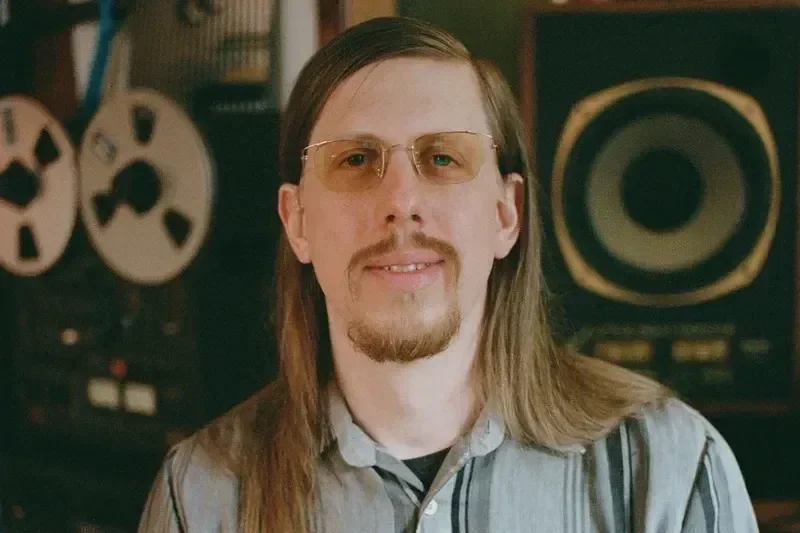What is time-based media?
Art that's not a 3D or 2D object. It's any art that happens over a period of time. In the art world, we consider time-based media to be 4D.
Do you have a background in recording?
I have none! My language is shot full of holes and I use a lot of my own terms because I learn as I go. This project is my first one. I began because I'm a visual artist. That's what I studied in grad school. I'm also a musician, so I started thinking about merging the two. Drums are my main instrument and I thought about what it would be like if I mounted drums to the roof of my car. What would they sound like when the rain hit them while I drove? It was exciting to think about and naturally I thought about how to record it. I needed to build a studio in my car! My first setup was just this janky thing with contact mics on the drums, cables running through the sunroof and duct tape sealing it up to keep out the water. After making some recordings, I realized I could have fun processing and manipulating what I had captured.
Where did you get the contact mics? How did you find the gear you needed?
The mics are from this wonderful woman at Cold Gold Audio in Vancouver, Canada. I bought an old PreSonus FirePod [now FP10], which meant I had up to eight mics with which to work. I could record multiple things at once! Later I added an extra battery and switch to the car to keep me from draining it completely — so I wouldn't get stuck. I rebuilt the alternator from a John Deere tractor and installed that so I could charge all of it really fast. An inverter powers everything, including any [stompboxes] I may be using. All of the sound gets recorded into a very old Mac. I collect the tracks in GarageBand, but export them to other programs for mixing.
What other things do you keep in the car?
Various mics and effects pedals. There are contact mic rigged things, like a taped together bundle of sticks and some skateboards you can "play" the wheels on. I also have an old Roland CR-8000 CompuRhythm drum machine from the '80s. It emits some sort of EMF waves that will blow speakers, even if the amp is across the room and the output of the machine isn't hooked up! Sound somehow comes out of the amp anyway, and eventually blows the speakers. We wrapped it in 10 layers of tinfoil and it fixed the problem.
So the car was loaded and ready to go! What did you do next?
At that point I realized if I could record the drums that were mounted to my car, I could record anything else, anywhere. I got this idea to record musicians in their natural environment and videotape it at the same time. The U.S. is a beautiful place that bands have been touring for awhile. I wanted to record the landscape and work with all the brilliant musicians that were all over the country, whom I've met over the years. My bandmates and I went on tour during the summer of 2010 up the East Coast, and then along the border, through Fargo, continued to Seattle, then dropped down to Los Angeles. We stopped in towns all along the way. We recorded everyone, from Rymodee of This Bike Is A Pipe Bomb to Terry Berlier who works at Stanford and makes and plays her own musical sculptures. I've also taken trips to specific places for festivals, like South By Southwest. I do all of my recording outside.
Tell me about a typical field recording session.
Well, they are all different. On tour, I let the musicians choose the location. They would know of a beautiful place that had wonderful sounds, because they were from there. We would take background noise into consideration. I can keep the monitors out of the way of the mics and [minimize bleed], so even though I have the ability to monitor through headphones I never do. One time I was in New York, working with Chica Vas. They are an all female drummer band, which includes Mindy Abovitz [of Tom Tom Magazine]. We decided to record under the BQE [Brooklyn-Queens Expressway] because it was the perfect noisy environment in which to record them. We had two microphones set up for the singers, two lines for the keyboards and ambient mics over the shoulders of the drummers. They move around a lot; it took about 90 minutes to set up after taking things like that into consideration. We captured an hour of audio and mixed it down to a 12-minute song.
So you take improvised music and cut it up?
The first few minutes [of that session] was one of their regular songs. But we were having so much fun and people were just coming up to see what was happening; this impromptu, improvised live show just grew out of it. So we kept rolling!
Did you ever have to alter your original idea for a session?
Once my amazing bandmate, Anthony Hlavaty, who was absolutely essential to the project, and Zach Lehrhoff of The Ex Models, set up tons of pedals and were ready to play, but I wasn't sure what I wanted to do. I looked though my stuff and found a hydrophone. In the middle of the bleak urban landscape was this pretty awesome mud puddle, right in front of us. So I submerged the mic, ran it through some effects and "played" the mud puddle. Later we had a shotgun mic set up so we picked up ice cream trucks, people chatting as they walked by and other wonderful urban sounds.
How do you edit once you get home with all of the sounds and music you've collected?
I always work with my friend Bill Roberts, who operated as chief engineer for 20 years at Warner Brothers Records. He used to work out of New Orleans. He's a total savant; he's been mixing and mastering forever. He took me under his wing. Bill uses Samplitude and Sound Forge. I use Logic for the junk I'm willing to fuck up. [laughs] I experiment, trip up and learn as I go. I sit next to Bill and he teaches me for the album that we're currently putting together. I've learned about EQing. He can correct any clipping, which, thankfully, there haven't been many. He's taught me the language associated with engineering, but also uses wonderful terms, like describing part of a song as "pretty hairy." [laughs] "We need to get the hair off of this part!" I remember him calling me once and saying, "Remember, we need to put metadata on these songs," and I'm like, "What the fuck is metadata?" [laughs]
Who is "Nam June Psyche?"
Nam June Paik was a video and sound artist who was very prolific. He and John Cage are heroes to me. When I was trying to figure out what to call this thing, one of my students, Stu, said I should call myself that.
Your background is in sculpture. Do you consider this an art project that also happens to be a studio, or vice versa?
It was conceived as an art project, but to other people it might be the opposite. It doesn't matter what you make, it's how you use it.
Where are you taking this idea next?
I'm interested in documenting communities with The Car Kit by capturing beautiful moments of sound for archiving, like Alan Lomax did. That's another place I'm moving towards. The Car is great. It's eye candy. When people see a bunch of drums strapped to a car, they freak out and ask questions; but the whole thing came from a genuine place of curiosity. It also made me realize that I'm not the only crazy person out there. People have asked to work with me, so I'm sure many other things will come from it. When the album is done, I'm going to put it out on cassette tape. I'm starting a tape label and I want to get more involved with musicians who want to make art sound objects. I'll travel around and record them with the car. I'm in the process of buying used tape duplicators.
Why cassette over a more modern format?
You'll be able to get a digital download too, but I love the sound of tape; it's cheap and vinyl is environmentally dirty. Tape isn't much better, but it can be reused and has a great DIY association. Also, I can duplicate tapes myself, unlike vinyl. It's fun making tapes all night!
Have you ever needed a jump start?
Oh god yes, at least five. At least I can count them on one hand!





